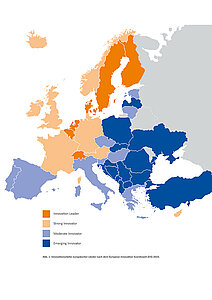The underestimated resource: regional structures as drivers of innovation
09.09.2025
In the context of innovation and transfer work, a region is more than just a location - it determines structural conditions and thus offers the potential for
business and science to become a driver of innovation.


Where groundbreaking ideas are really born
What factors create an innovative ecosystem? Which conditions are particularly advantageous in terms of innovation management? If we look at the innovative strength of European countries, there is no clear commonality among leading countries at first glance. (see Fig. 1)
Brilliant ideas do not necessarily emerge in the largest metropolitan areas, economies or regions.
So are there other key factors, such as the location of large corporations or prestigious research centers, that guarantee regional innovation?
Why do some regions manage to develop a lasting climate of innovation while others lag behind?
Fig. 1: Innovation strength of European countries according to the European Innovation Scoreboard (EIS) 2023.
Europe's Innovation Leader: How regional conditions accelerate innovation
A look at Europe's innovation leaders makes this clear:
Above all, it is crucial that the population knows and uses the existing strengths of regional innovation promotion.
By dealing with regional conditions and their individual advantages and disadvantages, SMEs can use these strategically and benefit from existing innovation policy in a targeted manner.
If companies are aware of existing networks and make active use of them, this drives the development and implementation of innovation. If the population understands the innovation policy and stands behind it, if local identities are established that promote curiosity and openness, then innovations are accelerated.

Best Case: Belgium
Belgium is one of the most innovative countries in Europe. The reason for this is no coincidence, but a lived recipe for success: close cooperation.
Belgium's innovative strength is based on a well thought-out regional ecosystem: clusters, networks and targeted funding programs ensure that companies can access the knowledge of local partners and quickly implement new ideas. At the same time, Belgium attaches great importance to international cooperation. This is demonstrated by numerous scientific co-publications and cross-border research projects. As the seat of the European Union, Brussels, the capital of Belgium, is the center of numerous international organizations, companies and institutions. This global and multicultural network facilitates a far-reaching exchange of ideas and developments.
Belgium connects science and business like no other country. They rely on close transfer partnerships, a dynamic start-up scene and networks with proximity. Universities and companies work hand in hand, start-ups benefit from targeted coaching and practical training programs. This climate of cooperation creates a fertile breeding ground in which ideas can not only emerge, but also find their way onto the market.
Finally, financial support for innovation is also a central pillar of Belgium's innovation policy, without which innovation could not be driven forward to the same extent.

Best case: Switzerland
Switzerland also impressively demonstrates how SMEs benefit from regional innovation policy and are thus able to build a globally leading innovation system.
Funding programs in Switzerland are predominantly designed for the long term. This creates planning security, reliability and enables a sustainable impact. Central to this is lnnosuisse, the national innovation agency, which uses clear funding structures to support projects that would not come to fruition without this assistance. With instruments such as financial support, coaching programs and targeted networking, it supports start-ups as well as established companies.
Switzerland boasts excellent educational and research institutions that are closely linked to the economy. Technology transfer works efficiently, enabling Swiss companies to quickly transform research results into marketable innovations. This is also reflected in a high patent density.
Finally, companies benefit from a stable political and economic environment. This is complemented by an innovation-friendly competitive principle: subsidies are awarded on a competitive basis, with state intervention only taking place in the event of market failure. This model ensures quality and individual responsibility in the innovation system.
In this way, Switzerland proves that innovation is not created by ideas alone, but by a well thought-out, functioning ecosystem.

Best Case: Sweden
Sweden is the country of start-ups. It lives entrepreneurship - sustainable and future-oriented - like hardly any other country. Entrepreneurship is encouraged and socially celebrated in Sweden. This successful start-up scene is supported by an ecosystem that emphasizes sustainability and gives young companies the chance to take off internationally with their ideas.
Independent government agencies such as Vinnova in particular ensure excellent innovation and business support in the country, initiating numerous strategic and mission-oriented measures.
In addition, the lifelong learning approach is promoted by these independent government agencies. The population has recognized the relevance of the approach and has also committed itself to it.
The unique collaborative and informal culture in the Swedish economy, across all industries and competitive sectors, also stands out. In general, technology transfer as a collaborative effort to "do things together" is deeply rooted in their mentality.

Tip for further reading: A look at the innovation leaders in Europe
How do innovation and technology transfer succeed in Europe?
The transfer study by Bayern Innovativ's Innovation Management team analyzes the innovation systems of three countries - Belgium, Sweden and Switzerland - in more detail.
Let us inspire you! Here you will receive numerous impulses on how innovation culture is successfully practiced.
Innovation starts on the doorstep
The examples from Sweden, Belgium and Switzerland have shown that regional innovative strength is created in particular where existing strengths are used and strategically expanded. The decisive levers are also available in Bavaria. An excellent ecosystem can be accessed both in the generation and application of knowledge.

Bavaria: home to knowledge and innovation
Bavaria has a strong knowledge and education infrastructure as well as a high density of private and public research institutions. From the universities in Munich and Erlangen to applied research at the Fraunhofer Institutes and the technology transfer centers in the regions: Knowledge is generated here on a broad scale. There is also a strong innovation base in large and medium-sized companies.
The existing cluster structures simplify the exchange of know-how and access to relevant partners and markets. This opens up a clear opportunity for SMEs: they can use these structures for their own innovation projects - for example through joint research projects, technology transfer or practical cooperation with universities.
Bavaria offers opportunities not only in the generation of knowledge, but also through its strengths in its exploitation. This can be seen in the high number of patents in key technologies, the R&D expenditure of the economy and a strong position in future-oriented industries. The number of employees in industrial high-tech sectors underlines this substance. Bavaria also benefits from high synergies between regional funding and EU funds, which further accelerate innovation.
This offers several advantages for SMEs: they benefit from synergies with large companies, can mobilize additional resources via EU funding and are embedded in an environment that actively promotes innovation. Those who specifically translate knowledge into products, services or business models have the best chance of being successful in international competition.
It is crucial that SMEs not only perceive these existing structures as background noise, but actively use them - through cooperation, networks and the strategic use of regional resources.
In this way, the location can become an international competitive advantage. After all, innovation needs a home base. It is created where companies interact with their environment - with the people, institutions and networks of their region. Now is the time to seize the opportunities on your doorstep for your own future viability.
Sources:
Bayern Innovativ GmbH. A look at the Innovation Leaders in Europe. Retrieved September 05, 2025 from www.bayern-innovativ.de/detail/studie-ein-blick-auf-die-innovation-leader-in-europa/
Bavarian State Ministry of Economic Affairs, Regional Development and Energy. (2021). Bavarian Innovation Strategy 2021-2027. Retrieved September 05, 2025 from https://www.stmwi.bayern.de/fileadmin/user_upload/stmwi/publikationen/pdf/2022-02-28_Innovationsland_Bayern.pdf
European Commission, Directorate-General for Research and Innovation, Hollanders, H., Es-Sadki, N., Khalilova, A., Cardoso, J. C. (2023). European Innovation
Scoreboard 2023. Retrieved March 14, 2023 from https://op.europa.eu/en/publication-detail/-/publication/04797497-25de-11ee%20a2d3-01aa75ed71a1
